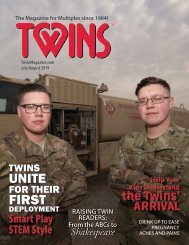Twins Magazine 2004 January February
Canadian family with four sets of twins sets Hardwired to Connect HMO forced to pay for TTTS surgery Holiday Survival Guide Oh my word! RSV season symptoms and strategies Sparkling Snowflakes The best-laid plans The hamster project Those “loving feelings” are hard to find Twins galore Two treatments help TTT babies Uh-oh! Toddler Trials and Training What causes monozygotic twinning Whining wears on single mom Help! I need somebody…
Canadian family with four sets of twins sets
Hardwired to Connect
HMO forced to pay for TTTS surgery
Holiday Survival Guide
Oh my word!
RSV season symptoms and strategies
Sparkling Snowflakes
The best-laid plans
The hamster project
Those “loving feelings” are hard to find
Twins galore
Two treatments help TTT babies
Uh-oh! Toddler Trials and Training
What causes monozygotic twinning
Whining wears on single mom
Help! I need somebody…
You also want an ePaper? Increase the reach of your titles
YUMPU automatically turns print PDFs into web optimized ePapers that Google loves.
the blood vessel connections actually
look like, and how easy it is to tackle
them at surgery.
Fetal surgery for TTT is done in
suitable cases by passing a fiber-optic
scope into the amniotic cavity of the
recipient twin. Shining a bright light on
the placental surface allows the surgeon
to see the connecting vessels that are
causing TTT. A laser beam is then
focused on the connections and the
vessels are heated until they collapse
and disappear. This stops the transfusion.
Complications include premature
onset of labor and rupture of the membranes.
The procedure is only done by
a few experienced surgeons in specialized
referral centers. We are still trying
to find out how best to deal with all
cases of TTT—severe and moderate.
TTT is a very difficult problem to
manage, and it may be some time
before we know the best way to go forward.
The main difficulty, however, is
to persuade people with fixed ideas
about management to recognize that
amniocentesis and fetal surgery
probably both have roles to play, and
that one method does not exclude the
other. We will really make progress
when the diagnosis of MC twinning is
made in the first trimester, and we have
the opportunity to tackle TTT cases at
an early stage, before they have gone
too far.
Geoffrey Machin, M.D., Ph.D., a fetal pathologist,
has been helping twins and their parents
with questions of zygosity for more
than 10 years. In that time, more than 300
twin pairs have had their zygosity determined
by DNA studies, and almost all of
them were MZ. He is co-author with Louis G.
Keith, M.D., of An Atlas of Multiple
Pregnancy—Biology and Pathology,
(Parthenon Publishing, 1999) and authored
the chapters on triplet zygosity in Triplet
pregnancies and their consequences, edited
by Louis G. Keith, M.D., and Isaac
Blickstein, M.D., (Parthenon Publishing,
2003). You may e-mail your questions to him
at geoffmachin@shaw.ca.
www.TwinsMagazine.com JANUARY/FEBRUARY 2004 11

















